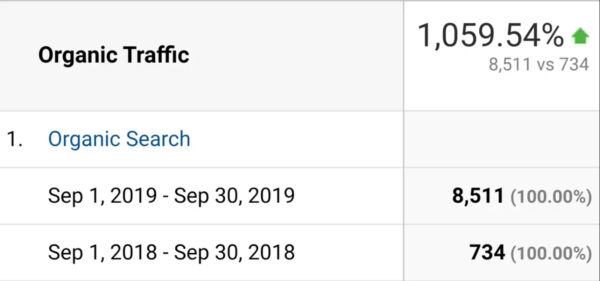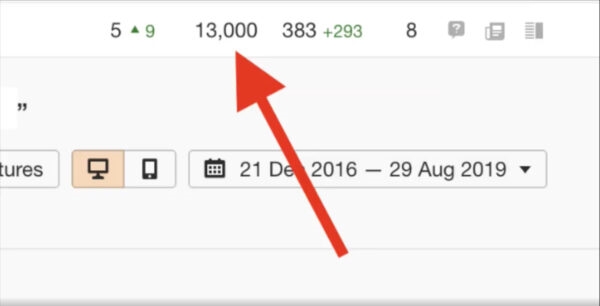To start this article, I have to say I used to suck at SEO and I spent so much time doing stuff that doesn’t work, then one day I realized that 99.9% of SEO advice is trash. So I stopped reading, watching, and consuming. Instead, I sat down and asked one question. What is important in SEO? That’s when I discovered that what you don’t do is just as important as what you do. What if you could grow your traffic while working less. Well, that’s only possible if you focus on the right stuff. Like how I grew this client’s organic search traffic by 1,000% by focusing on just one blog post.

Using Ring method on my client
But I didn’t just write a blog post. I applied a unique SEO method. It’s amazing because you can grow SEO traffic without creating any new content. Then just stack the two bonus techniques that I’m going to show you later, and this becomes one of the most powerful weapons in your SEO routine. I call it the Ring technique. And it’s simply the process of consolidating similar content assets into a single mother content asset.
So here are the exact steps:
- Identify content assets that are targeting the same or very similar keyword phrases.
- Decide what your mother’s asset is going to be.
- Map out how you are going to consolidate all of these similar content assets into a single mother asset.
- Consolidate all of that content into one.
- 301 redirect all the supporting assets to the mother asset.
- Annotate your actions in Google Analytics so you can track the performance of your new asset.
- make sure you acquire quality backlinks to this new asset because now it’s worth promoting.
And it is done.
The Ring technique works for several reasons:
- it increases word count: consolidating assets into one will naturally increase word count, which is often correlated to better rankings.
- it produces deeper content: The truth is, spreading your knowledge across multiple micro-posts creates a ton of thin content. While consolidating your assets produces the opposite effect.
- it eliminates keyword cannibalization: keyword cannibalization occurs when more than one page is targeting the same keyword phrase and then Google has to decide which one to rank. And you mustn’t have any ambiguity in your keyword targeting. That’s why consolidating assets is one way to just eradicate this issue.
- it consolidates authority. You’ll be 301 redirecting all your supporting assets to one page, so that means your mother page is gonna acquire all of the links that those micro-posts had originally. As a result, your mother asset will turn into an authoritative powerhouse, which will help to rank much easier.
- it makes content promotion way easier: It’s much easier to promote one asset than it is to promote 10 different assets. And also, people are more willing to link to an in-depth, high-quality piece of content than they are to a 300-word blog post that’s very vague and not super in-depth.
So in the case of our customer, we identified a keyword that had 13,000 searches per month, and then we built the entire mother asset around that keyword. And then we just began that process of consolidating all of the thin content that we found in the site into this mother asset.

So our client is in the fashion niche and they had a ton of images, so we had to figure out how to consolidate all those images in a way that wouldn’t make it super hard to read and make it incredibly long, so we created a slider that the user could just skip through the images and see all the different outfits.

The Slider that we used
So far, we’ve consolidated 11 thin pieces of content into this single mother asset. And now this content is over 5,000 words. And there’s no denying that this process took several months to execute, but it is worth it. And the truth is, I’ve taken this exact strategy, the Ring technique, and used it across multiple verticals. And it has worked 100% of the time. It is so incredibly powerful when you execute it correctly. The biggest key to the success of this strategy is to make sure that the mother asset is targeting the right keyword. So after you’ve found the right keyword, you’ve consolidated your asset, now all you need to do is acquire quality links to that asset and watch the performance climb.
Now two more bonus tactics will take this strategy to another level. The first bonus method is to simply take all the comments from all the posts that you’ve consolidated and added those to the mother asset, and what that’s going to do, is it’s gonna add a ton of user-generated content to that page and it’s going to give you a ton of unique content and that’s just going to add levels to the content and make it deeper and deeper. And if you’re on WordPress, you can easily do this by just downloading the Copy/Move Comment plugin, and you’ll be able to just take all those comments and add ’em to your mother asset. Now one key point, before you do this, is making sure the comments are relevant.
The second bonus tactic is to leverage title modifiers. Now, this blog post that I’m talking about, it was getting a ton of traffic for its primary phrase, but believe it or not, it’s getting the most traffic for a phrase that’s using a title modifier. So all we did was simply just add the year to the title. And of course, you can’t always use this tactic, but in this particular instance, it made sense for us to add a year, because fashion does change, therefore we need to continually update this post for the users.
Conclusion
This method works mostly for companies that have good incoming organic traffic with moderate DA (Domain Authority) on their blog articles and want to increase their traffic without writing new content.
So if you tried this method and it worked, please share your experience with others here.
Digital & Social Articles on Business 2 Community
(39)









